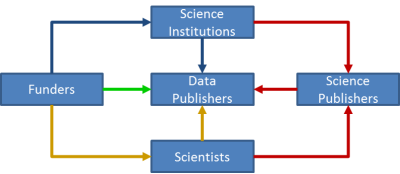Costs & Benefits
Benefits
KomFor is a one-stop competence centre for research data and delivers its services and expert knowledge in conformity with the community referred to.
The associated data centres provide integrated tools, services and know-how according to their competences. As are part of the family of ICSU – World Data Service, they are by definition integrated and linked to other WDCs worldwide and are long established and reliant partners to this community and contribute their expertise to all aspects of research data management (RDM).
The German National Library (TIB) in cooperation with the global consortium DataCite contributes the services for the accessibility from research data. The TIB has long years experience in delivering information and a long-standing relationship to students and researchers in its specialized fields.
The merger will above all benefit researchers at higher education and research institutions. Scientific research nowadays involves an increasing number of large and complex datasets. This ‘Big Data’ demands large-scale computing capacity, extensive data storage facilities, visualisation facilities and high-quality user support, combined with advanced network facilities. The combination of facilities created by the merger will provide for all this on a long-term basis.
Costs for different service level
Various forms, formats, sizes and levels of complexity of data packages require different resource quantities.
The data centres have been collecting, storing, archiving and distributing vast amounts of observational data collected from sensing satellites, data infrastructures, modelling and other large scale instruments with automatic processing for several decades now.
The raw data collected is homogeneous with standard data- and metadata formats and is distributed to the science community as climate research quality data products. The science community uses these data products to address important science questions, and their analyses can influence major policy decisions.
Comparable low amounts of data are collected in individual settings i.e. in the field or in the laboratory. This data is heterogeneous and neither the format nor the description are standardised. Various amounts of editorial work are required to publish this expensively produced data.
Cost models of KomFor data centers
PANGAEA
For archiving and publication of data supplementary to a science article we calculate in average 500€. At present services supplied to individual scientists are free. Donations are welcome.
Science projects using our data management services are charged in average between 2-5% of the overall project funding. The share depends on the actual efforts needed for the project and has to be negotiated.
Services supplied may include:
- data ingest, archiving, and publication of data produced in the project
- rescue of legacy data from previous projects and initiatives as well as mobilisation of data from literature
- support for data integration and data products
- setup of a project related web site and/or data portal
WDCC/DKRZ
The following description refers to data resulting from large scale simulations. As bases for a first estimate the DKRZ calculated an example of long-term preservation at World Data Center for Climate. In detail the costs depends on data quality, homogeneity and is negotiated.
The fees for an external project arise for:
- Creating and inclusion of meta data into the CERA data base and in cooperation the data sets into the data base system (personal costs)
- Costs for storage media (several tape generations)
- Running costs for HSM-System operation, data base and internet access
- Optional: assignment of Digital Object Identifiers (DOI)
Example cost estimation (in German only) can be found here.
WDC-RSAT
WDC-RSAT offers long-term storage for scientific data and information products in the field of atmosphere-related research.
For storing data products of external project fees arise from the following action items:
- Define, generate and categorize content of metadata in cooperation with the scientific data providers.
- Import scientific data into WDC-RSAT infrastructure:
- Harmonization of data and metadata,
- Format transformation of data,
- Metadata generation and
- DOI registration (on request).
- Internet access:
- Customized development of portal infrastructure (Webportals) in cooperation with scientific data providers.
- As far as possible existing standardized data handling services are re-used.
- Running costs arise for storage devices (harddrives and tapes), data base maintenance (costs for WDC-RSAT-staff members), hardware maintenance, online access.
- Long-term storage by German Remote Sensing Library (German: D-SDA) is available on request one the basis of an additional agreement. Additional costs according to the D-SDA pricing catalogue are being discussed (see here)
General cost compensation model

In a very general sense the compensation of data management costs can be described as possible ways how funds could flow between the different stakeholders including funding organisations, science institutions, individual scientist, science publishers, and - as a common final destination - data centers, resp. data publishers. The different ways are indicated by colors:
- Blue: costs compensated through science institutions hosting the data center. Science institutions in turn claim higher cost at their funding organisations
- Green: costs compensated through funding organisations directly
- By getting a financial share in science projects (project data management)
- By getting directly refunded for archiving & publishing data outside of their host institutions or funded projects (requires evidence of expenses, e.g. through ticket system)
- Yellow: Scientists pay invidually for the publication of their data. They might make use of corresponding funds at their funding organisation.
- Red: Data centers/publishers get a share of subscription or open access fees. In turn scientists or science institutions would have to compensate for the higher costs.



